Learning Journal - Cities and Climate Change
VerifiedAdded on 2022/08/26
|11
|1613
|6
AI Summary
Contribute Materials
Your contribution can guide someone’s learning journey. Share your
documents today.
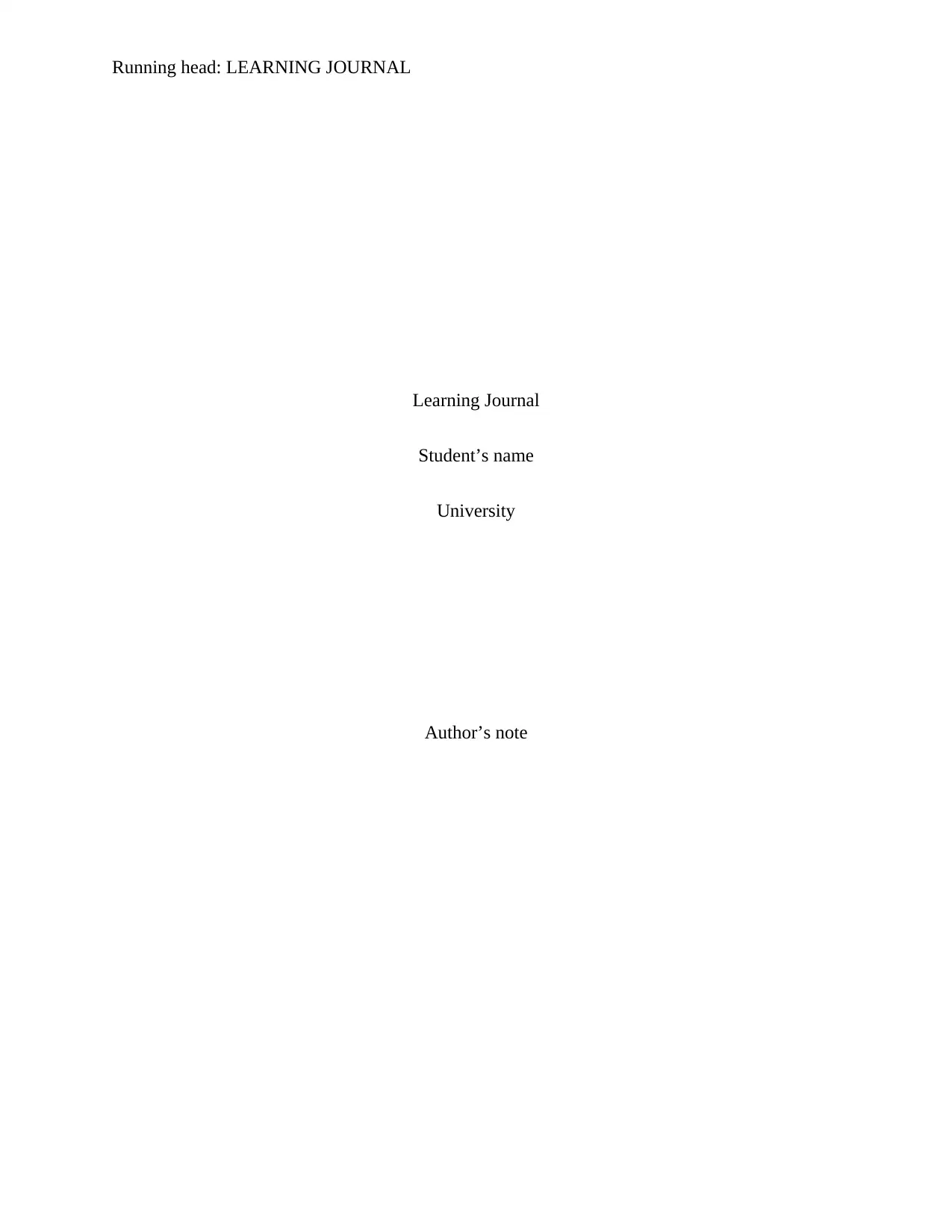
Running head: LEARNING JOURNAL
Learning Journal
Student’s name
University
Author’s note
Learning Journal
Student’s name
University
Author’s note
Secure Best Marks with AI Grader
Need help grading? Try our AI Grader for instant feedback on your assignments.
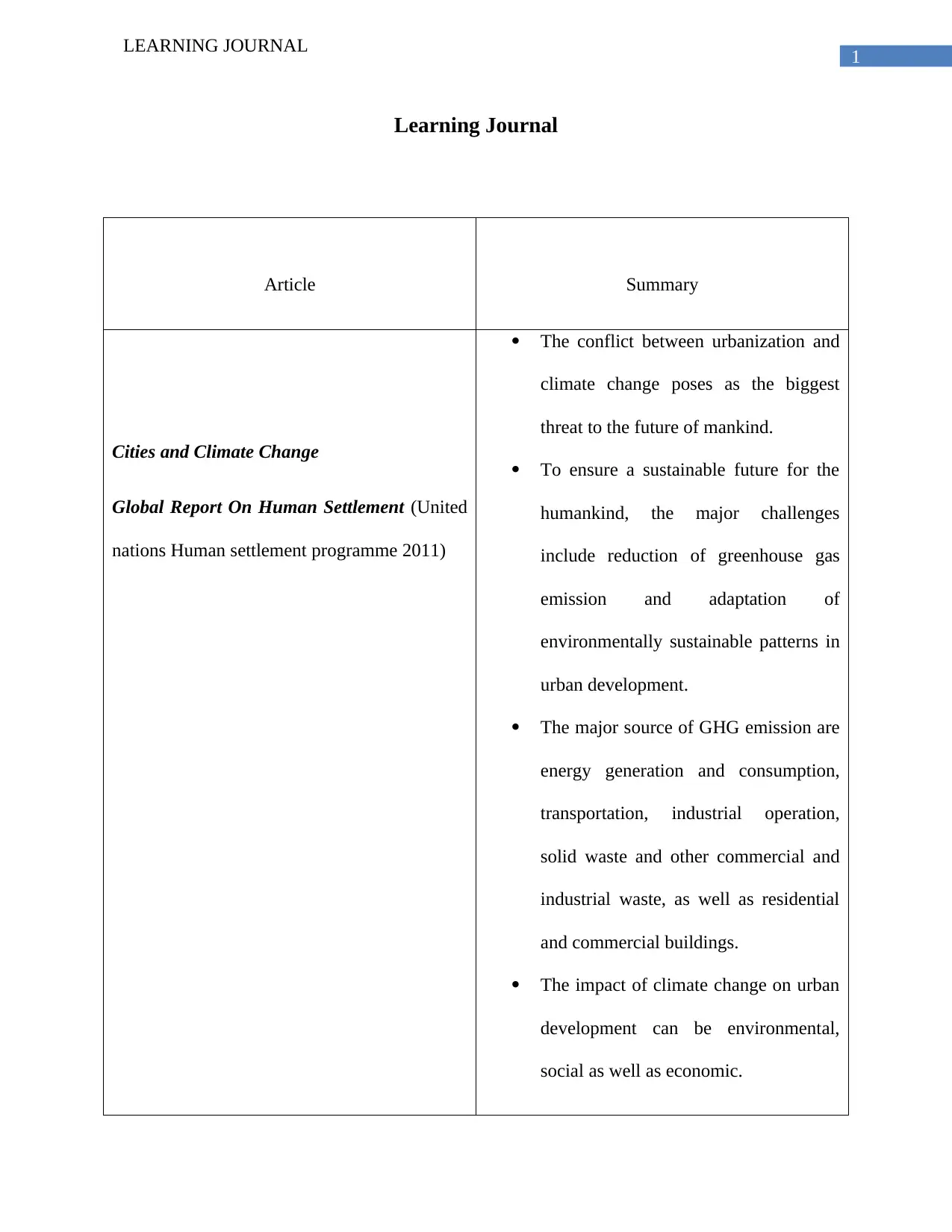
1
LEARNING JOURNAL
Learning Journal
Article Summary
Cities and Climate Change
Global Report On Human Settlement (United
nations Human settlement programme 2011)
The conflict between urbanization and
climate change poses as the biggest
threat to the future of mankind.
To ensure a sustainable future for the
humankind, the major challenges
include reduction of greenhouse gas
emission and adaptation of
environmentally sustainable patterns in
urban development.
The major source of GHG emission are
energy generation and consumption,
transportation, industrial operation,
solid waste and other commercial and
industrial waste, as well as residential
and commercial buildings.
The impact of climate change on urban
development can be environmental,
social as well as economic.
LEARNING JOURNAL
Learning Journal
Article Summary
Cities and Climate Change
Global Report On Human Settlement (United
nations Human settlement programme 2011)
The conflict between urbanization and
climate change poses as the biggest
threat to the future of mankind.
To ensure a sustainable future for the
humankind, the major challenges
include reduction of greenhouse gas
emission and adaptation of
environmentally sustainable patterns in
urban development.
The major source of GHG emission are
energy generation and consumption,
transportation, industrial operation,
solid waste and other commercial and
industrial waste, as well as residential
and commercial buildings.
The impact of climate change on urban
development can be environmental,
social as well as economic.

2
LEARNING JOURNAL
Cities and Climate Change
Global Report On Human Settlement (United
nations Human settlement programme 2011)
(contd.)
Rise of see level, increase of tropical
cyclones, increased instances of urban
flooding due to severe precipitation and
extreme heat are all results of climate
change.
The extreme climate and weather
conditions can also affect the economic
and social environments of urban
regions by damaging infrastructures
such as roads, bridges, buildings, water
supply, energy provisions etc.
The five key sectors where mitigation
action are occurring include the built
environment, urban infrastructure,
urban form and structure, transport and
carbon sequestration.
Community-based adaptation responses
are urgently required in the context of
urbanization-climate change conflict
that includes expansion of community
participation, risk assessment and
investment in major infrastructure.
LEARNING JOURNAL
Cities and Climate Change
Global Report On Human Settlement (United
nations Human settlement programme 2011)
(contd.)
Rise of see level, increase of tropical
cyclones, increased instances of urban
flooding due to severe precipitation and
extreme heat are all results of climate
change.
The extreme climate and weather
conditions can also affect the economic
and social environments of urban
regions by damaging infrastructures
such as roads, bridges, buildings, water
supply, energy provisions etc.
The five key sectors where mitigation
action are occurring include the built
environment, urban infrastructure,
urban form and structure, transport and
carbon sequestration.
Community-based adaptation responses
are urgently required in the context of
urbanization-climate change conflict
that includes expansion of community
participation, risk assessment and
investment in major infrastructure.
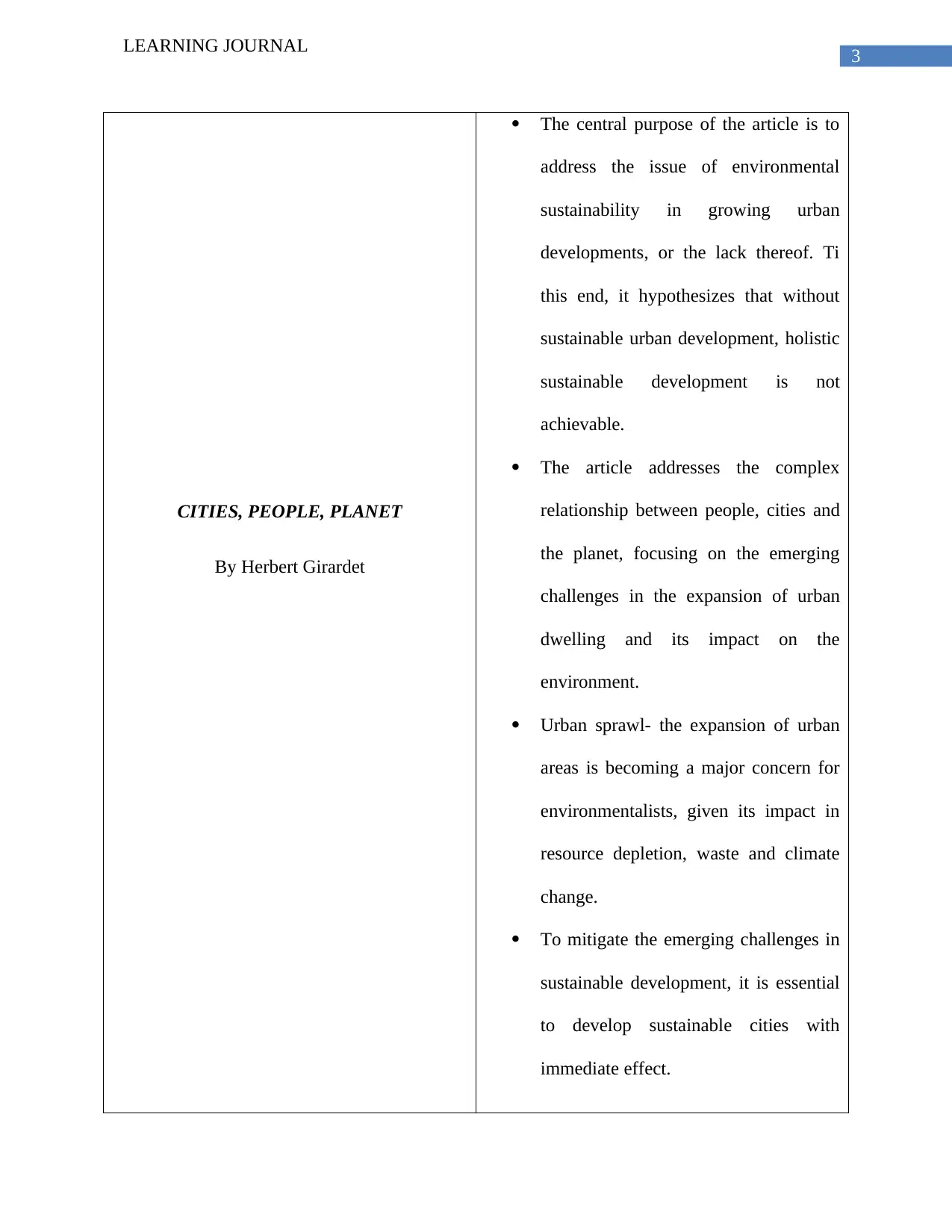
3
LEARNING JOURNAL
CITIES, PEOPLE, PLANET
By Herbert Girardet
The central purpose of the article is to
address the issue of environmental
sustainability in growing urban
developments, or the lack thereof. Ti
this end, it hypothesizes that without
sustainable urban development, holistic
sustainable development is not
achievable.
The article addresses the complex
relationship between people, cities and
the planet, focusing on the emerging
challenges in the expansion of urban
dwelling and its impact on the
environment.
Urban sprawl- the expansion of urban
areas is becoming a major concern for
environmentalists, given its impact in
resource depletion, waste and climate
change.
To mitigate the emerging challenges in
sustainable development, it is essential
to develop sustainable cities with
immediate effect.
LEARNING JOURNAL
CITIES, PEOPLE, PLANET
By Herbert Girardet
The central purpose of the article is to
address the issue of environmental
sustainability in growing urban
developments, or the lack thereof. Ti
this end, it hypothesizes that without
sustainable urban development, holistic
sustainable development is not
achievable.
The article addresses the complex
relationship between people, cities and
the planet, focusing on the emerging
challenges in the expansion of urban
dwelling and its impact on the
environment.
Urban sprawl- the expansion of urban
areas is becoming a major concern for
environmentalists, given its impact in
resource depletion, waste and climate
change.
To mitigate the emerging challenges in
sustainable development, it is essential
to develop sustainable cities with
immediate effect.
Paraphrase This Document
Need a fresh take? Get an instant paraphrase of this document with our AI Paraphraser
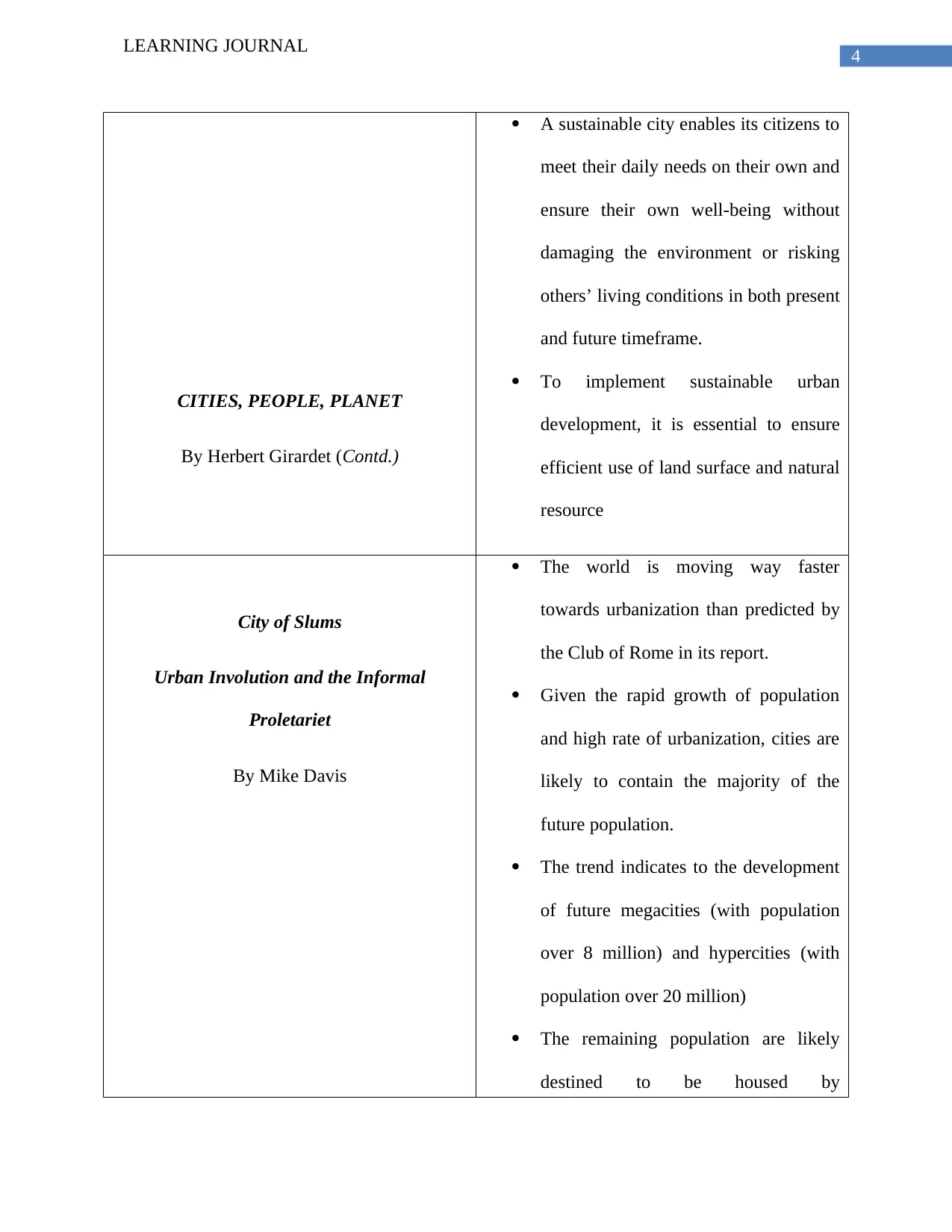
4
LEARNING JOURNAL
CITIES, PEOPLE, PLANET
By Herbert Girardet (Contd.)
A sustainable city enables its citizens to
meet their daily needs on their own and
ensure their own well-being without
damaging the environment or risking
others’ living conditions in both present
and future timeframe.
To implement sustainable urban
development, it is essential to ensure
efficient use of land surface and natural
resource
City of Slums
Urban Involution and the Informal
Proletariet
By Mike Davis
The world is moving way faster
towards urbanization than predicted by
the Club of Rome in its report.
Given the rapid growth of population
and high rate of urbanization, cities are
likely to contain the majority of the
future population.
The trend indicates to the development
of future megacities (with population
over 8 million) and hypercities (with
population over 20 million)
The remaining population are likely
destined to be housed by
LEARNING JOURNAL
CITIES, PEOPLE, PLANET
By Herbert Girardet (Contd.)
A sustainable city enables its citizens to
meet their daily needs on their own and
ensure their own well-being without
damaging the environment or risking
others’ living conditions in both present
and future timeframe.
To implement sustainable urban
development, it is essential to ensure
efficient use of land surface and natural
resource
City of Slums
Urban Involution and the Informal
Proletariet
By Mike Davis
The world is moving way faster
towards urbanization than predicted by
the Club of Rome in its report.
Given the rapid growth of population
and high rate of urbanization, cities are
likely to contain the majority of the
future population.
The trend indicates to the development
of future megacities (with population
over 8 million) and hypercities (with
population over 20 million)
The remaining population are likely
destined to be housed by
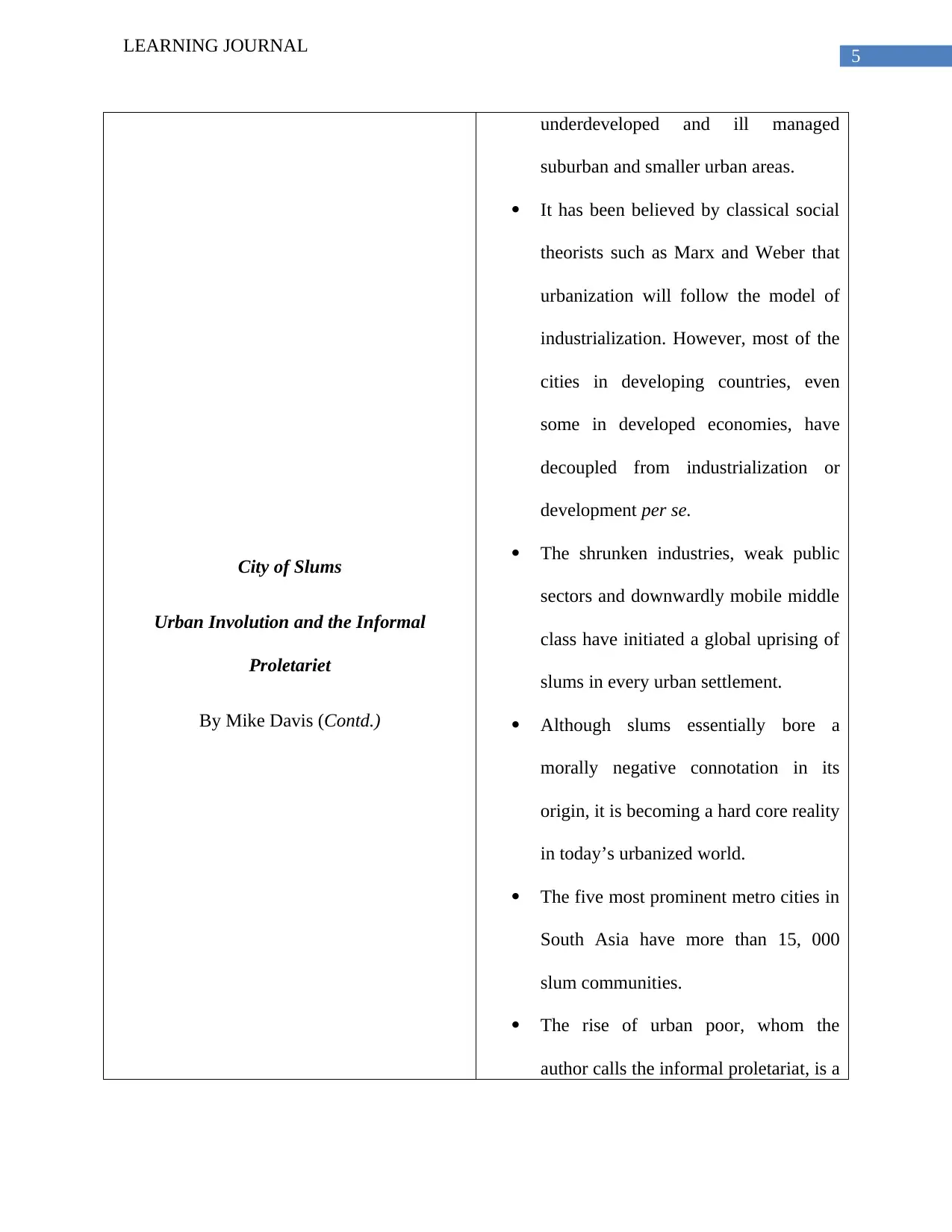
5
LEARNING JOURNAL
City of Slums
Urban Involution and the Informal
Proletariet
By Mike Davis (Contd.)
underdeveloped and ill managed
suburban and smaller urban areas.
It has been believed by classical social
theorists such as Marx and Weber that
urbanization will follow the model of
industrialization. However, most of the
cities in developing countries, even
some in developed economies, have
decoupled from industrialization or
development per se.
The shrunken industries, weak public
sectors and downwardly mobile middle
class have initiated a global uprising of
slums in every urban settlement.
Although slums essentially bore a
morally negative connotation in its
origin, it is becoming a hard core reality
in today’s urbanized world.
The five most prominent metro cities in
South Asia have more than 15, 000
slum communities.
The rise of urban poor, whom the
author calls the informal proletariat, is a
LEARNING JOURNAL
City of Slums
Urban Involution and the Informal
Proletariet
By Mike Davis (Contd.)
underdeveloped and ill managed
suburban and smaller urban areas.
It has been believed by classical social
theorists such as Marx and Weber that
urbanization will follow the model of
industrialization. However, most of the
cities in developing countries, even
some in developed economies, have
decoupled from industrialization or
development per se.
The shrunken industries, weak public
sectors and downwardly mobile middle
class have initiated a global uprising of
slums in every urban settlement.
Although slums essentially bore a
morally negative connotation in its
origin, it is becoming a hard core reality
in today’s urbanized world.
The five most prominent metro cities in
South Asia have more than 15, 000
slum communities.
The rise of urban poor, whom the
author calls the informal proletariat, is a

6
LEARNING JOURNAL
result of ill-managed structural
development.
Surviving Two Billion Cars: China Must
Lead the Way
By Deborah Gordon and Daniel Sperling
The article addresses the perils of
automobile intensification all over the
world, and its forthcoming impact on
the environment and the humanity as a
whole.
The demands of automobile are
increasing day by day, and it is
prominent all across the world. The
world has more than 1 billion cars at
present, and it is likely to cross the 2
billion mark by 2020.
If the increasing demands are met with
traditional vehicles run by traditional
fuel, the pollution and emission level
will be sufficient to beckon a global
catastrophe.
To avoid the disaster, whoever can
introduce transportation innovation will
gain economically as well as politically,
so opines the authors.
The most prominent solution to this
LEARNING JOURNAL
result of ill-managed structural
development.
Surviving Two Billion Cars: China Must
Lead the Way
By Deborah Gordon and Daniel Sperling
The article addresses the perils of
automobile intensification all over the
world, and its forthcoming impact on
the environment and the humanity as a
whole.
The demands of automobile are
increasing day by day, and it is
prominent all across the world. The
world has more than 1 billion cars at
present, and it is likely to cross the 2
billion mark by 2020.
If the increasing demands are met with
traditional vehicles run by traditional
fuel, the pollution and emission level
will be sufficient to beckon a global
catastrophe.
To avoid the disaster, whoever can
introduce transportation innovation will
gain economically as well as politically,
so opines the authors.
The most prominent solution to this
Secure Best Marks with AI Grader
Need help grading? Try our AI Grader for instant feedback on your assignments.
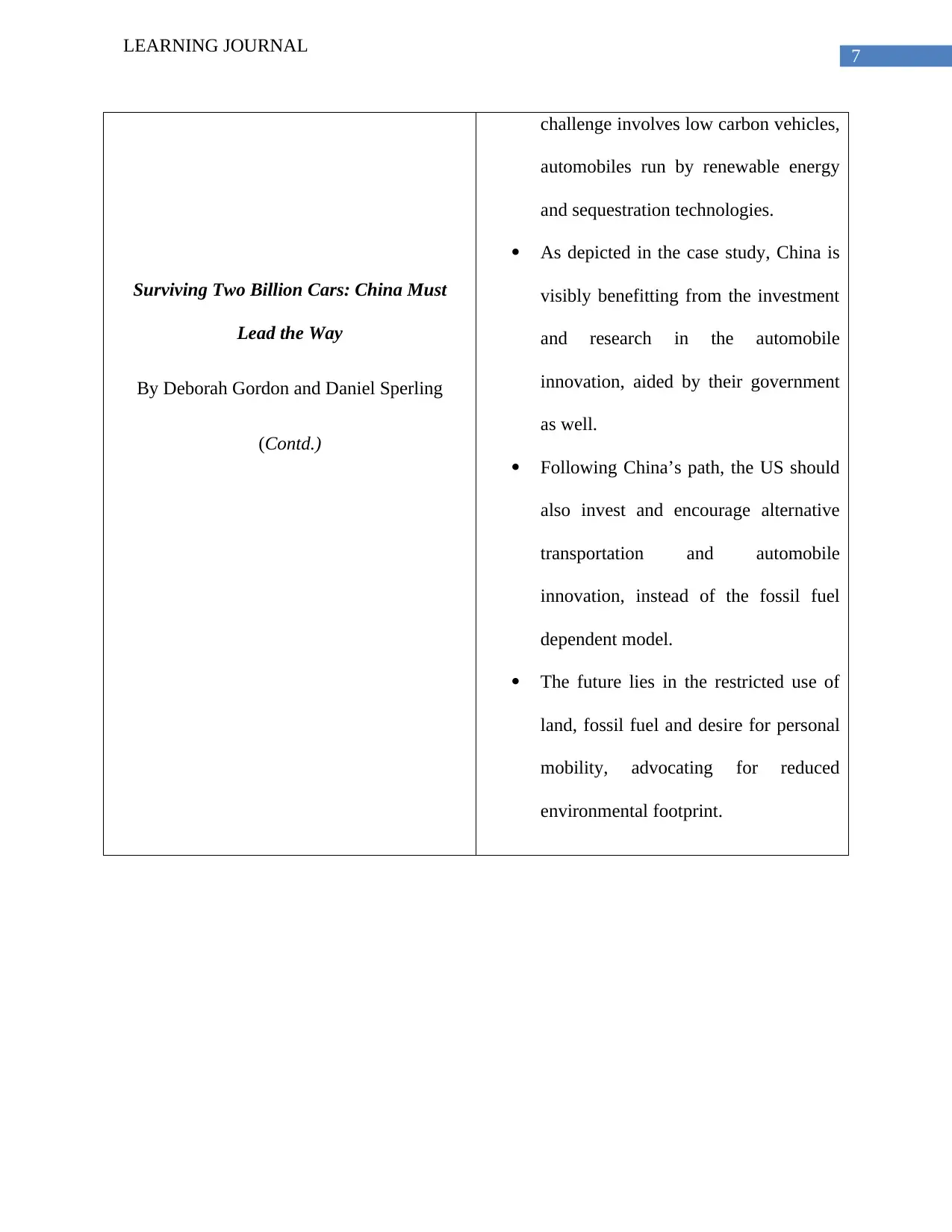
7
LEARNING JOURNAL
Surviving Two Billion Cars: China Must
Lead the Way
By Deborah Gordon and Daniel Sperling
(Contd.)
challenge involves low carbon vehicles,
automobiles run by renewable energy
and sequestration technologies.
As depicted in the case study, China is
visibly benefitting from the investment
and research in the automobile
innovation, aided by their government
as well.
Following China’s path, the US should
also invest and encourage alternative
transportation and automobile
innovation, instead of the fossil fuel
dependent model.
The future lies in the restricted use of
land, fossil fuel and desire for personal
mobility, advocating for reduced
environmental footprint.
LEARNING JOURNAL
Surviving Two Billion Cars: China Must
Lead the Way
By Deborah Gordon and Daniel Sperling
(Contd.)
challenge involves low carbon vehicles,
automobiles run by renewable energy
and sequestration technologies.
As depicted in the case study, China is
visibly benefitting from the investment
and research in the automobile
innovation, aided by their government
as well.
Following China’s path, the US should
also invest and encourage alternative
transportation and automobile
innovation, instead of the fossil fuel
dependent model.
The future lies in the restricted use of
land, fossil fuel and desire for personal
mobility, advocating for reduced
environmental footprint.
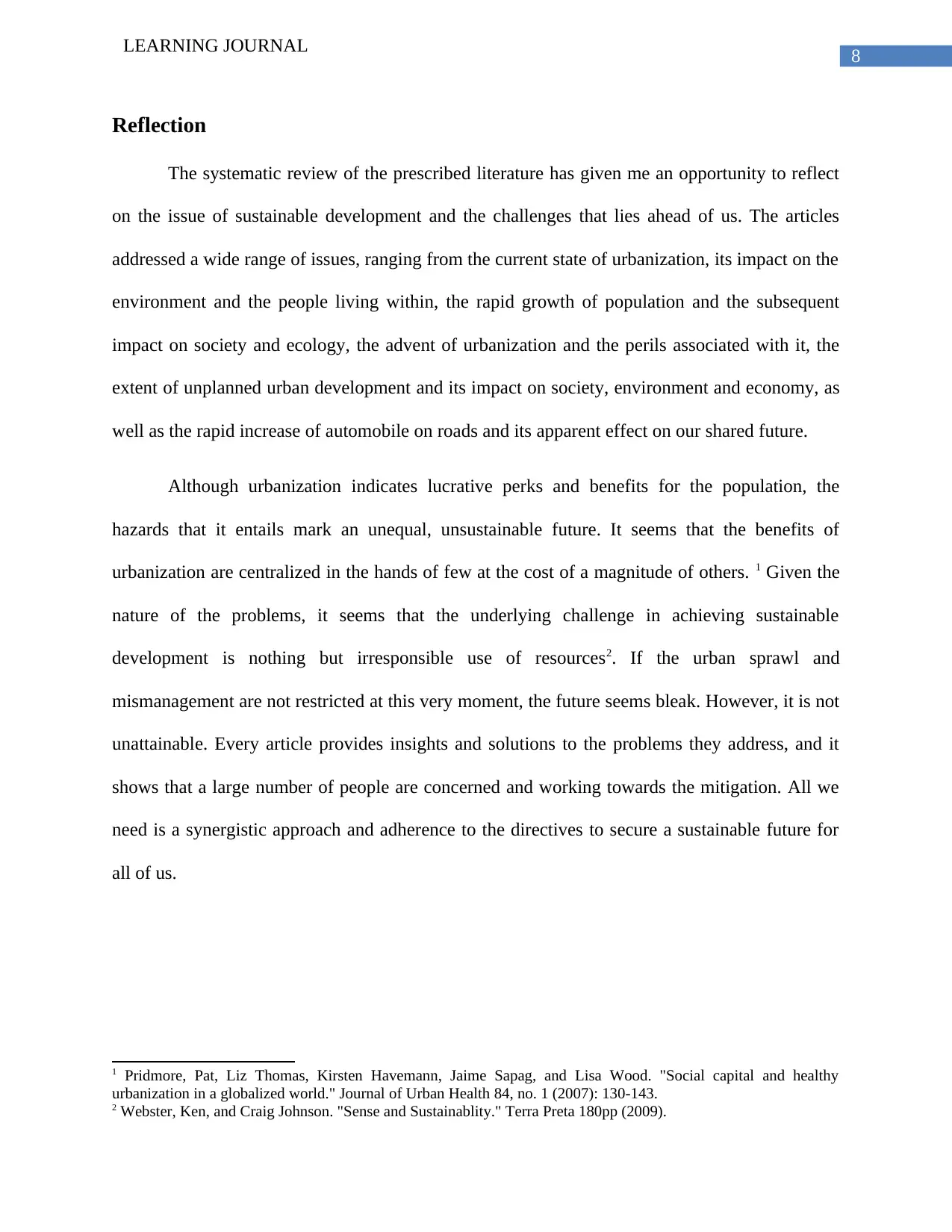
8
LEARNING JOURNAL
Reflection
The systematic review of the prescribed literature has given me an opportunity to reflect
on the issue of sustainable development and the challenges that lies ahead of us. The articles
addressed a wide range of issues, ranging from the current state of urbanization, its impact on the
environment and the people living within, the rapid growth of population and the subsequent
impact on society and ecology, the advent of urbanization and the perils associated with it, the
extent of unplanned urban development and its impact on society, environment and economy, as
well as the rapid increase of automobile on roads and its apparent effect on our shared future.
Although urbanization indicates lucrative perks and benefits for the population, the
hazards that it entails mark an unequal, unsustainable future. It seems that the benefits of
urbanization are centralized in the hands of few at the cost of a magnitude of others. 1 Given the
nature of the problems, it seems that the underlying challenge in achieving sustainable
development is nothing but irresponsible use of resources2. If the urban sprawl and
mismanagement are not restricted at this very moment, the future seems bleak. However, it is not
unattainable. Every article provides insights and solutions to the problems they address, and it
shows that a large number of people are concerned and working towards the mitigation. All we
need is a synergistic approach and adherence to the directives to secure a sustainable future for
all of us.
1 Pridmore, Pat, Liz Thomas, Kirsten Havemann, Jaime Sapag, and Lisa Wood. "Social capital and healthy
urbanization in a globalized world." Journal of Urban Health 84, no. 1 (2007): 130-143.
2 Webster, Ken, and Craig Johnson. "Sense and Sustainablity." Terra Preta 180pp (2009).
LEARNING JOURNAL
Reflection
The systematic review of the prescribed literature has given me an opportunity to reflect
on the issue of sustainable development and the challenges that lies ahead of us. The articles
addressed a wide range of issues, ranging from the current state of urbanization, its impact on the
environment and the people living within, the rapid growth of population and the subsequent
impact on society and ecology, the advent of urbanization and the perils associated with it, the
extent of unplanned urban development and its impact on society, environment and economy, as
well as the rapid increase of automobile on roads and its apparent effect on our shared future.
Although urbanization indicates lucrative perks and benefits for the population, the
hazards that it entails mark an unequal, unsustainable future. It seems that the benefits of
urbanization are centralized in the hands of few at the cost of a magnitude of others. 1 Given the
nature of the problems, it seems that the underlying challenge in achieving sustainable
development is nothing but irresponsible use of resources2. If the urban sprawl and
mismanagement are not restricted at this very moment, the future seems bleak. However, it is not
unattainable. Every article provides insights and solutions to the problems they address, and it
shows that a large number of people are concerned and working towards the mitigation. All we
need is a synergistic approach and adherence to the directives to secure a sustainable future for
all of us.
1 Pridmore, Pat, Liz Thomas, Kirsten Havemann, Jaime Sapag, and Lisa Wood. "Social capital and healthy
urbanization in a globalized world." Journal of Urban Health 84, no. 1 (2007): 130-143.
2 Webster, Ken, and Craig Johnson. "Sense and Sustainablity." Terra Preta 180pp (2009).
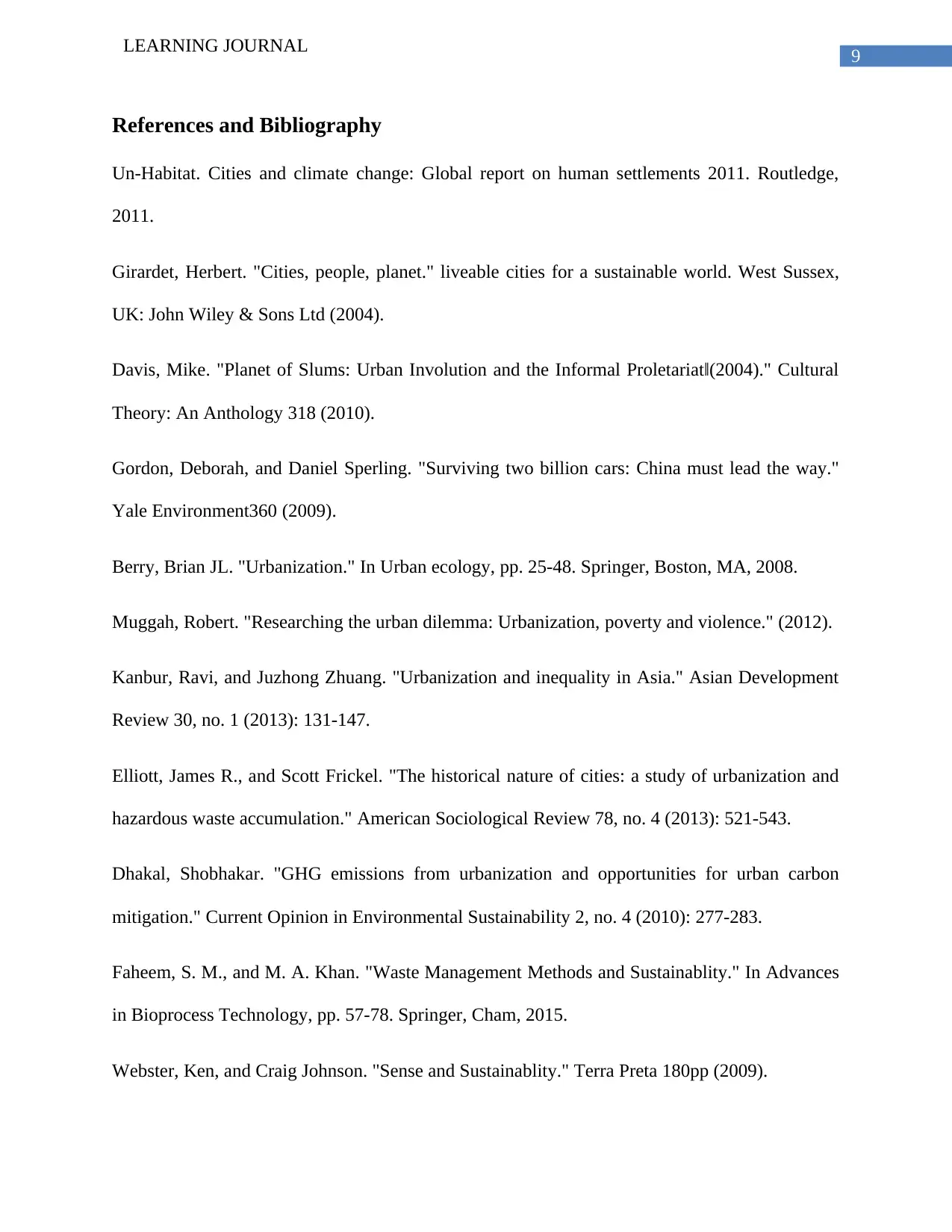
9
LEARNING JOURNAL
References and Bibliography
Un-Habitat. Cities and climate change: Global report on human settlements 2011. Routledge,
2011.
Girardet, Herbert. "Cities, people, planet." liveable cities for a sustainable world. West Sussex,
UK: John Wiley & Sons Ltd (2004).
Davis, Mike. "Planet of Slums: Urban Involution and the Informal Proletariat‖(2004)." Cultural
Theory: An Anthology 318 (2010).
Gordon, Deborah, and Daniel Sperling. "Surviving two billion cars: China must lead the way."
Yale Environment360 (2009).
Berry, Brian JL. "Urbanization." In Urban ecology, pp. 25-48. Springer, Boston, MA, 2008.
Muggah, Robert. "Researching the urban dilemma: Urbanization, poverty and violence." (2012).
Kanbur, Ravi, and Juzhong Zhuang. "Urbanization and inequality in Asia." Asian Development
Review 30, no. 1 (2013): 131-147.
Elliott, James R., and Scott Frickel. "The historical nature of cities: a study of urbanization and
hazardous waste accumulation." American Sociological Review 78, no. 4 (2013): 521-543.
Dhakal, Shobhakar. "GHG emissions from urbanization and opportunities for urban carbon
mitigation." Current Opinion in Environmental Sustainability 2, no. 4 (2010): 277-283.
Faheem, S. M., and M. A. Khan. "Waste Management Methods and Sustainablity." In Advances
in Bioprocess Technology, pp. 57-78. Springer, Cham, 2015.
Webster, Ken, and Craig Johnson. "Sense and Sustainablity." Terra Preta 180pp (2009).
LEARNING JOURNAL
References and Bibliography
Un-Habitat. Cities and climate change: Global report on human settlements 2011. Routledge,
2011.
Girardet, Herbert. "Cities, people, planet." liveable cities for a sustainable world. West Sussex,
UK: John Wiley & Sons Ltd (2004).
Davis, Mike. "Planet of Slums: Urban Involution and the Informal Proletariat‖(2004)." Cultural
Theory: An Anthology 318 (2010).
Gordon, Deborah, and Daniel Sperling. "Surviving two billion cars: China must lead the way."
Yale Environment360 (2009).
Berry, Brian JL. "Urbanization." In Urban ecology, pp. 25-48. Springer, Boston, MA, 2008.
Muggah, Robert. "Researching the urban dilemma: Urbanization, poverty and violence." (2012).
Kanbur, Ravi, and Juzhong Zhuang. "Urbanization and inequality in Asia." Asian Development
Review 30, no. 1 (2013): 131-147.
Elliott, James R., and Scott Frickel. "The historical nature of cities: a study of urbanization and
hazardous waste accumulation." American Sociological Review 78, no. 4 (2013): 521-543.
Dhakal, Shobhakar. "GHG emissions from urbanization and opportunities for urban carbon
mitigation." Current Opinion in Environmental Sustainability 2, no. 4 (2010): 277-283.
Faheem, S. M., and M. A. Khan. "Waste Management Methods and Sustainablity." In Advances
in Bioprocess Technology, pp. 57-78. Springer, Cham, 2015.
Webster, Ken, and Craig Johnson. "Sense and Sustainablity." Terra Preta 180pp (2009).
Paraphrase This Document
Need a fresh take? Get an instant paraphrase of this document with our AI Paraphraser
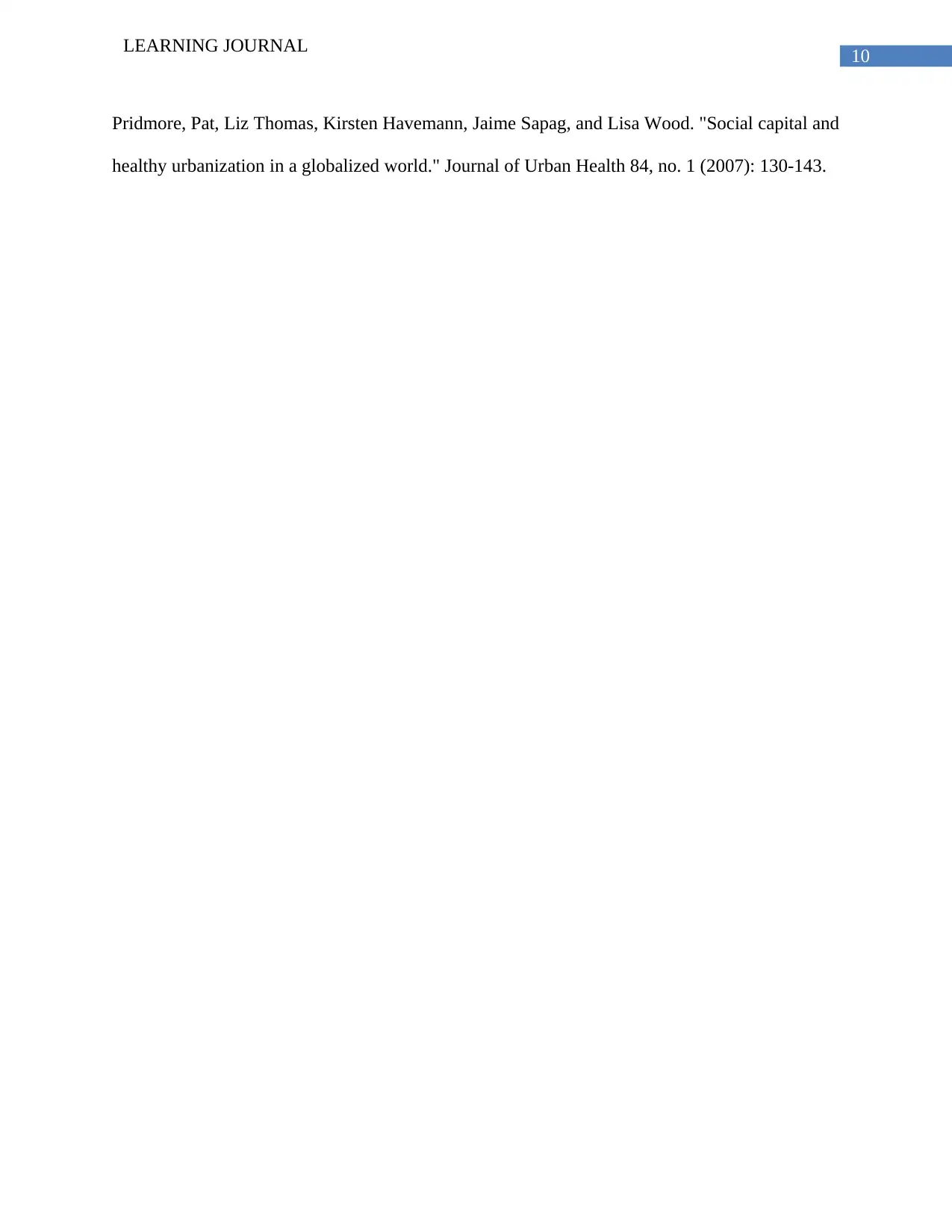
10
LEARNING JOURNAL
Pridmore, Pat, Liz Thomas, Kirsten Havemann, Jaime Sapag, and Lisa Wood. "Social capital and
healthy urbanization in a globalized world." Journal of Urban Health 84, no. 1 (2007): 130-143.
LEARNING JOURNAL
Pridmore, Pat, Liz Thomas, Kirsten Havemann, Jaime Sapag, and Lisa Wood. "Social capital and
healthy urbanization in a globalized world." Journal of Urban Health 84, no. 1 (2007): 130-143.
1 out of 11
Related Documents
Your All-in-One AI-Powered Toolkit for Academic Success.
+13062052269
info@desklib.com
Available 24*7 on WhatsApp / Email
![[object Object]](/_next/static/media/star-bottom.7253800d.svg)
Unlock your academic potential
© 2024 | Zucol Services PVT LTD | All rights reserved.





